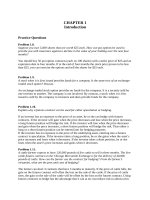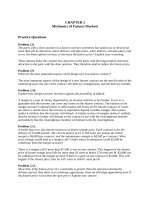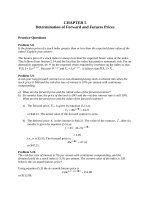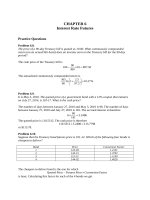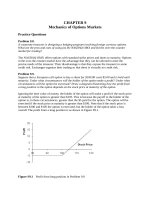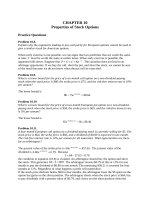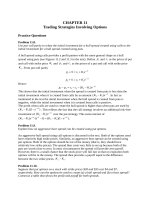Solutions fundamentals of futures and options markets 7e by hull chapter 02
Bạn đang xem bản rút gọn của tài liệu. Xem và tải ngay bản đầy đủ của tài liệu tại đây (104.23 KB, 6 trang )
CHAPTER 2
Mechanics of Futures Markets
Practice Questions
Problem 2.8.
The party with a short position in a futures contract sometimes has options as to the precise
asset that will be delivered, where delivery will take place, when delivery will take place, and
so on. Do these options increase or decrease the futures price? Explain your reasoning.
These options make the contract less attractive to the party with the long position and more
attractive to the party with the short position. They therefore tend to reduce the futures price.
Problem 2.9.
What are the most important aspects of the design of a new futures contract?
The most important aspects of the design of a new futures contract are the specification of the
underlying asset, the size of the contract, the delivery arrangements, and the delivery months.
Problem 2.10.
Explain how margins protect investors against the possibility of default.
A margin is a sum of money deposited by an investor with his or her broker. It acts as a
guarantee that the investor can cover any losses on the futures contract. The balance in the
margin account is adjusted daily to reflect gains and losses on the futures contract. If losses
are above a certain level, the investor is required to deposit a further margin. This system
makes it unlikely that the investor will default. A similar system of margins makes it unlikely
that the investor’s broker will default on the contract it has with the clearinghouse member
and unlikely that the clearinghouse member will default with the clearinghouse.
Problem 2.11.
A trader buys two July futures contracts on frozen orange juice. Each contract is for the
delivery of 15,000 pounds. The current futures price is 160 cents per pound, the initial
margin is $6,000 per contract, and the maintenance margin is $4,500 per contract. What
price change would lead to a margin call? Under what circumstances could $2,000 be
withdrawn from the margin account?
There is a margin call if more than $1,500 is lost on one contract. This happens if the futures
price of frozen orange juice falls by more than 10 cents to below 150 cents per lb. $2,000 can
be withdrawn from the margin account if there is a gain on one contract of $1,000. This will
happen if the futures price rises by 6.67 cents to 166.67 cents per lb.
Problem 2.12.
Show that, if the futures price of a commodity is greater than the spot price during the
delivery period, then there is an arbitrage opportunity. Does an arbitrage opportunity exist if
the futures price is less than the spot price? Explain your answer.
If the futures price is greater than the spot price during the delivery period, an arbitrageur
buys the asset, shorts a futures contract, and makes delivery for an immediate profit. If the
futures price is less than the spot price during the delivery period, there is no similar perfect
arbitrage strategy. An arbitrageur can take a long futures position but cannot force immediate
delivery of the asset. The decision on when delivery will be made is made by the party with
the short position. Nevertheless companies interested in acquiring the asset will find it
attractive to enter into a long futures contract and wait for delivery to be made.
Problem 2.13.
Explain the difference between a market-if-touched order and a stop order.
A market-if-touched order is executed at the best available price after a trade occurs at a
specified price or at a price more favorable than the specified price. A stop order is executed
at the best available price after there is a bid or offer at the specified price or at a price less
favorable than the specified price.
Problem 2.14.
Explain what a stop-limit order to sell at 20.30 with a limit of 20.10 means.
A stop-limit order to sell at 20.30 with a limit of 20.10 means that as soon as there is a bid at
20.30 the contract should be sold providing this can be done at 20.10 or a higher price.
Problem 2.15.
At the end of one day a clearinghouse member is long 100 contracts, and the settlement price
is $50,000 per contract. The original margin is $2,000 per contract. On the following day the
member becomes responsible for clearing an additional 20 long contracts, entered into at a
price of $51,000 per contract. The settlement price at the end of this day is $50,200. How
much does the member have to add to its margin account with the exchange clearinghouse?
The clearinghouse member is required to provide 20 �$2 000 $40 000 as initial margin for
the new contracts. There is a gain of (50,200 50,000) �100 $20,000 on the existing
contracts. There is also a loss of (51 000 50 200) �20 $16 000 on the new contracts. The
member must therefore add
40 000 20 000 16 000 $36 000
to the margin account.
Problem 2.16.
On July 1, 2010, a Japanese company enters into a forward contract to buy $1 million with
yen on January 1, 2011. On September 1, 2010, it enters into a forward contract to sell $1
million on January 1, 2011. Describe the profit or loss the company will make in dollars as a
function of the forward exchange rates on July 1, 2010 and September 1, 2010.
Suppose F1 and F2 are the forward exchange rates for the contracts entered into July 1, 2010
and September 1, 2010, and S is the spot rate on January 1, 2011. (All exchange rates are
measured as yen per dollar). The payoff from the first contract is ( S F1 ) million yen and the
payoff from the second contract is ( F2 S ) million yen. The total payoff is therefore
( S F1 ) ( F2 S ) ( F2 F1 ) million yen.
Problem 2.17.
The forward price on the Swiss franc for delivery in 45 days is quoted as 1.1000. The futures
price for a contract that will be delivered in 45 days is 0.9000. Explain these two quotes.
Which is more favorable for an investor wanting to sell Swiss francs?
The 1.1000 forward quote is the number of Swiss francs per dollar. The 0.9000 futures quote
is the number of dollars per Swiss franc. When quoted in the same way as the futures price
the forward price is 1 11000 09091 . The Swiss franc is therefore more valuable in the
forward market than in the futures market. The forward market is therefore more attractive
for an investor wanting to sell Swiss francs.
Problem 2.18.
Suppose you call your broker and issue instructions to sell one July hogs contract. Describe
what happens.
Hog futures are traded on the Chicago Mercantile Exchange. (See Table 2.2). The broker will
request some initial margin. The order will be relayed by telephone to your broker’s trading
desk on the floor of the exchange (or to the trading desk of another broker).
It will be sent by messenger to a commission broker who will execute the trade according to
your instructions. Confirmation of the trade eventually reaches you. If there are adverse
movements in the futures price your broker may contact you to request additional margin.
Problem 2.19.
“Speculation in futures markets is pure gambling. It is not in the public interest to allow
speculators to trade on a futures exchange.” Discuss this viewpoint.
Speculators are important market participants because they add liquidity to the market.
However, contracts must be useful for hedging as well as speculation. This is because
regulators generally only approve contracts when they are likely to be of interest to hedgers
as well as speculators.
Problem 2.20.
Identify the three commodities whose futures contracts in Table 2.2 have the highest open
interest.
Based on the contract months listed, the answer is crude oil, corn, and sugar (world).
Problem 2.21.
What do you think would happen if an exchange started trading a contract in which the
quality of the underlying asset was incompletely specified?
The contract would not be a success. Parties with short positions would hold their contracts
until delivery and then deliver the cheapest form of the asset. This might well be viewed by
the party with the long position as garbage! Once news of the quality problem became widely
known no one would be prepared to buy the contract. This shows that futures contracts are
feasible only when there are rigorous standards within an industry for defining the quality of
the asset. Many futures contracts have in practice failed because of the problem of defining
quality.
Problem 2.22.
“When a futures contract is traded on the floor of the exchange, it may be the case that the
open interest increases by one, stays the same, or decreases by one.” Explain this statement.
If both sides of the transaction are entering into a new contract, the open interest increases by
one. If both sides of the transaction are closing out existing positions, the open interest
decreases by one. If one party is entering into a new contract while the other party is closing
out an existing position, the open interest stays the same.
Problem 2.23.
Suppose that on October 24, 2010, you take a short position in an April 2011 live-cattle
futures contract. You close out your position on January 21, 2011. The futures price (per
pound) is 91.20 cents when you enter into the contract, 88.30 cents when you close out your
position, and 88.80 cents at the end of December 2010. One contract is for the delivery of
40,000 pounds of cattle. What is your total profit? How is it taxed if you are (a) a hedger and
(b) a speculator? Assume that you have a December 31 year end.
The total profit is
40 000 �(09120 08830) $1160
If you are a hedger this is all taxed in 2011. If you are a speculator
40 000 �(09120 08880) $960
is taxed in 2010 and
40 000 �(08880 08830) $200
is taxed in 2011.
Further Questions
Problem 2.24
Trader A enters into futures contracts to buy 1 million euros for 1.4 million dollars in three
months. Trader B enters in a forward contract to do the same thing. The exchange (dollars
per euro) declines sharply during the first two months and then increases for the third month
to close at 1.4300. Ignoring daily settlement, what is the total profit of each trader? When the
impact of daily settlement is taken into account, which trader does better?
The total profit of each trader in dollars is 0.03×1,000,000 = 30,000. Trader B’s profit is
realized at the end of the three months. Trader A’s profit is realized day-by-day during the
three months. Substantial losses are made during the first two months and profits are made
during the final month. It is likely that Trader B has done better because Trader A had to
finance its losses during the first two months.
Problem 2.25
Explain what is meant by open interest. Why does the open interest usually decline during the
month preceding the delivery month? On a particular day there are 2,000 trades in a
particular futures contract. Of the 2,000 traders on the long side of the market, 1,400 were
closing out position and 600 were entering into new positions. Of the 2,000 traders on the
short side of the market, 1,200 were closing out position and 800 were entering into new
positions. What is the impact of the day's trading on open interest?
Open interest is the number of contract outstanding. Many traders close out their positions
just before the delivery month is reached. This is why the open interest declines during the
month preceding the delivery month. The open interest went down by 600. We can see this in
two ways. First, 1,400 shorts closed out and there were 800 new shorts. Second, 1,200 longs
closed out and there were 600 new longs.
Problem 2.26
One orange juice future contract is on 15,000 pounds of frozen concentrate. Suppose that in
September 2009 a company sells a March 2011 orange juice futures contract for 120 cents
per pound. In December 2009 the futures price is 140 cents. In December 2010 the futures
price is 110 cents. In February 2011 the futures price is 125 cents. The company has a
December year end. What is the company's profit or loss on the contract? How is it realized?
What is the accounting and tax treatment of the transaction is the company is classified as a)
a hedger and b) a speculator?
The price goes up during the time the company holds the contract from 120 to 125 cents per
pound. Overall the company therefore takes a loss of 15,000×0.05 = $750. If the company is
classified as a hedger this loss is realized in 2011, If it is classified as a speculator it realizes a
loss of 15,000×0.20 = $3000 in 2009, a gain of 15,000×0.30 = $4,500 in 2010 and a loss of
15,000×0.15 = $2,250 in 2011.
Problem 2.27.
A company enters into a short futures contract to sell 5,000 bushels of wheat for 250 cents
per bushel. The initial margin is $3,000 and the maintenance margin is $2,000. What price
change would lead to a margin call? Under what circumstances could $1,500 be withdrawn
from the margin account?
There is a margin call if $1000 is lost on the contract. This will happen if the price of wheat
futures rises by 20 cents from 250 cents to 270 cents per bushel. $1500 can be withdrawn if
the futures price falls by 30 cents to 220 cents per bushel.
Problem 2.28.
Suppose that there are no storage costs for crude oil and the interest rate for borrowing or
lending is 5% per annum. How could you make money on August 4, 2009 by trading
December 2009 and June 2010 contracts on crude oil? Use Table 2.2.
The December 2009 settlement price for oil is $75.62 per barrel. The June 2010 settlement
price for oil is $79.41 per barrel. You could go long one December 2009 oil contract and short
one June 2010 contract. In December 2009 you take delivery of the oil borrowing $75.62 per
barrel at 5% to meet cash outflows. The interest accumulated in six months is about
75.62×0.05×0.5 or $1.89. In December the oil is sold for $79.41 per barrel which is more
than the amount that has to be repaid on the loan. The strategy therefore leads to a profit.
Note that this profit is independent of the actual price of oil in June 2010 or December 2009.
It will be slightly affected by the daily settlement procedures.
Problem 2.29.
What position is equivalent to a long forward contract to buy an asset at K on a certain date
and a put option to sell it for K on that date?
The equivalent position is a long position in a call with strike price K .
Problem 2.30. (Excel file)
The author’s Web page (www.rotman.utoronto.ca/~hull/data) contains daily closing prices for
the December 2001 crude oil futures contract and the December 2001 gold futures contract.
(Both contracts are traded on NYMEX.) You are required to download the data and answer
the following:
a) How high do the maintenance margin levels for oil and gold have to be set so that
there is a 1% chance that an investor with a balance slightly above the maintenance
margin level on a particular day has a negative balance two days later (i.e. one day
after a margin call). How high do they have to be for a 0.1% chance. Assume daily
price changes are normally distributed with mean zero.
b) Imagine an investor who starts with a long position in the oil contract at the
beginning of the period covered by the data and keeps the contract for the whole of
the period of time covered by the data. Margin balances in excess of the initial margin
are withdrawn. Use the maintenance margin you calculated in part (a) for a 1% risk
level and assume that the maintenance margin is 75% of the initial margin. Calculate
the number of margin calls and the number of times the investor has a negative
margin balance and therefore an incentive to walk away. Assume that all margin calls
are met in your calculations. Repeat the calculations for an investor who starts with a
short position in the gold contract.
The data for this problem in the 7th edition is different from that in the 6th edition.
a) For gold the standard deviation of daily changes is $15.184 per ounce or $1518.4 per
contract. For a 1% risk this means that the maintenance margin should be set at
1518.4 2 2.3263 or 4996 when rounded. For a 0.1% risk the maintenance
margin should be set at 1518.4 2 3.0902 or 6636 when rounded.
For crude oil the standard deviation of daily changes is $1.5777 per barrel or $1577.7
per contract. For a 1% risk, this means that the maintenance margin should be set at
1577.7 2 2.3263 or 5191 when rounded. For a 0.1% chance the maintenance
margin should be set at 1577.7 2 3.0902 or 6895 when rounded. NYMEX
might be interested in these calculations because they indicate the chance of a trader
who is just above the maintenance margin level at the beginning of the period having
a negative margin level before funds have to be submitted to the broker.
b) For a 1% risk the initial margin is set at 6,921 for on crude oil. (This is the
maintenance margin of 5,191 divided by 0.75.) As the spreadsheet shows, for a long
investor in oil there are 157 margin calls and 9 times (out of 1039 days) where the
investor is tempted to walk away. For a 1% risk the initial margin is set at 6,661 for
gold. (This is 4,996 divided by 0.75.) As the spreadsheet shows, for a short investor in
gold there are 81 margin calls and 4 times (out of 459 days) when the investor is
tempted to walk away. When the 0.1% risk level is used there is 1 time when the oil
investor might walk away and 2 times when the gold investor might do so.
